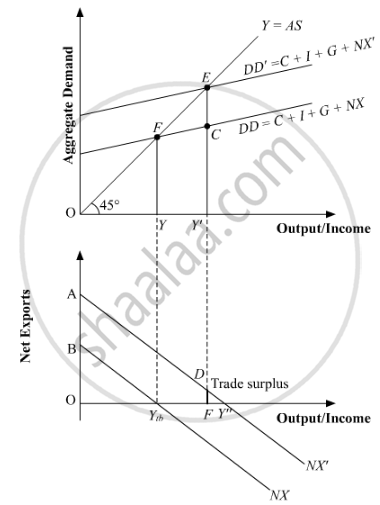Advertisements
Advertisements
प्रश्न
Answer the following question.
"Indian Rupee (₹) plunged to an all-time low of ₹ 74.48 against the US Dollar ($)".
− The Economic Times
In light of the above report, discuss the impact of the situation on Indian Imports.
उत्तर
Indian Rupee is depreciating against the US Dollar since it is given that " Indian Rupee (₹) plunged to an all-time low of ₹ 74.48 against the US Dollar ($)".A high exchange rate makes the imports more expensive. Consequently, a rise in the exchange rate implies a reduction in the demand for imports and vice-versa.
When imports fall, net exports (Exports - Imports) of a country rise. The given figure explains this process as follows:
Suppose the initial equilibrium income is given by Ye that corresponds to a trade balance equal to Ytb. With the rise in the net export demand, the aggregate demand curve DD shifts upwards to DD' such that the new equilibrium is established at point E' and the equilibrium income rises to Y'.
In the lower panel due to the fall in the imports, the net export rises and the net export curve shifts upwards from NX to NX'.At the new level of income, the net exports is represented by the vertical distance AE' which are necessarily positive (because the total demand curve DD' lies above the aggregate demand curve AD). Thus, with a fall in imports, there is a trade surplus. This trade surplus is represented in the lower panel by the vertical length DF.

संबंधित प्रश्न
What do you understand by ‘parametric shift of a line’? How does a line shift when its (i) slope decreases, and (ii) its intercept increases?
Measure the level of ex-ante aggregate demand when autonomous investment and consumption expenditure (A) is Rs 50 crores, and MPS is 0.2 and level of income (Y) is Rs 4000 crores. State whether the economy is in equilibrium or not (cite reasons).
Which of the following is NOT a stock variable?
"In an economy ex-ante Aggregate Demand is more than ex-ante Aggregate Supply."
Explain its impact on the level of output, income and employment.
Suppose for a given economy,
S = -60 + 0.1Y
I = ₹ 4,000 crore
(Where S = Saving Function, Y = National Income and I = Investment Expenditure)
Equilibrium level of Income would be ₹ ______ crore.
